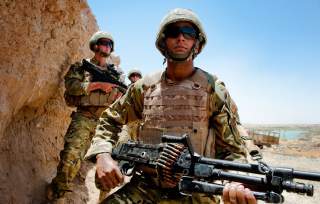Tank Robots Protected Marines in ‘First-Time’ British War Simulation
The future might be now.
The U.S. and Russian militaries also are moving quickly to integrate armed robots into their ground forces.
Robots in the air, on the ocean surface and on the ground guarded British Royal Marines as they stormed a beach during an important April 2019 war game.
The ground robot, in particular, is a new capability for the Royal Marines. The gun- and rocket-armed, tank-like unmanned ground vehicle could boost the naval branch’s firepower while helping to keep human beings out of harm’s way.
Alpha Company of the Royal Marines’ 40 Commando and their robot guardians stormed a beach in Cornwall in southwest England as part of Exercise Commando Warrior. The Royal Marines’ 1 Assault Group supported the naval infantry.
(This first appeared in April 2019.)
“Commando Warrior was the first time Royal Marines have used the autonomous vehicles during tactical action,” the Royal Navy reported.
While advancing towards the beach, the marines were being supported by an unmanned boat cruising the coastline looking for enemy forces both on land and at sea, using its on-board cameras and sensors.
Meanwhile, a small unmanned air system, similar to a drone, was looking from the skies for any signs of danger and two unmanned ground vehicles were providing overwatch and fire support if necessary.
The UGVs in question are variants of QinetiQ’s jeep-sized, tracked Titan.
“Titan is a highly modular platform that allows different superstructures to be mounted and integrated onto the middle vehicular platform for complex missions such as rescue, transport and reconnaissance,” QinetiQ explained on its website.
The Titan models that supported the Marines carry heavy machine guns and rockets. In a twist, one version of Titan can carry its own, smaller UGV that itself also is armed.
“With the autonomous vehicles looking on, the Royal Marines raided the beach, climbed the cliffs, took out ‘enemy’ forces patrolling and abseiled back to the sandy shore,” the navy stated of the April 2019 war game.
“It is about reinventing the force with new technology that’s available,” the Navy quoted marine corporal Scott Shaw as saying.
The U.S. and Russian militaries also are moving quickly to integrate armed robots into their ground forces.
The U.S. Army has begun shopping around for a robotic armored vehicle that can replace some of the branch's old M-2 Bradley manned fighting vehicles.
The Optionally-Manned Fighting Vehicle could operate with or without a human crew, allowing commanders to deploy the vehicles on missions that are too risky for human beings.
Some initial testing took place as early as 2017. An armed, robotic M-113 tracked armored vehicle provided covering fire for soldiers during a summer 2017 war game in Michigan.
For the exercise, engineers added a remotely-controlled machine gun to a remotely-controlled M-113. The operators of the M-113 and its machine gun followed behind the drone in an M-577 command vehicle, issuing commands via radio.
The Russian army is developing its own robotic vehicles and running experiments in order to develop tactics for deploying the unmanned systems. The new tactics point to Russia's growing determination to field, on the ground and in the air, meaningful numbers of armed robots.
The Kremlin is using the tracked, tank-size Marker ground robot for these tactical experiments. A video the Russian government released in March 2019 depicts a mixed crew of human and robot scouts feeding information to a main force of large, tank-like drones.
"Marker is built to be modular, with open information architecture," reported Kelsey Atherton wrote. "One configuration for the testbed arms it with a Kalashnikov-produced machine gun and a part of anti-tank grenade launchers. We can safely expect to see it test a range of weapons."
The Royal Marines’ mock beach assault could help to inform QinetiQ’s development of more sophisticated UGVs. “Teams behind the unmanned vehicles were at Tregantle Beach to watch how the equipment performed in a live action situation,” the Navy reported.
“Images and information were fed back to them to be analyzed while at the same time being routed to a hand-held tablet operated by the marines on the ground.”
“This has been a ground-breaking exercise,” marine colonel Chris Haw, the Commando Warrior exercise director, told the navy.
David Axe serves as Defense Editor of the National Interest. He is the author of the graphic novels War Fix, War Is Boring and Machete Squad.
Image: Wikimedia

